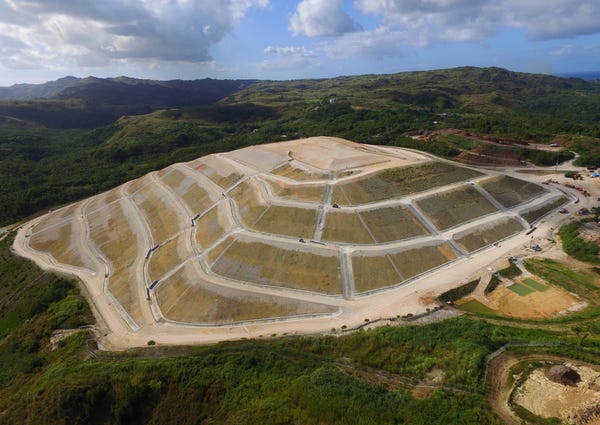Makings of a Good Landfill Closure Plan

Landfill closure plans should start from the day a site is permitted, continue through its active life and, all along, operators should consider what they will need to show regulators once they are ready to install the final cap. They will need to demonstrate gas and leachate collections systems and stormwater management systems are operating in a manner to ensure the site is “functionally stable,” meaning waste won’t pose a significant risk to the environment or human health. (See here)
They must demonstrate they are financially positioned to support what is typically a 30-year post closure term. And there needs to be advanced planning to the extent possible for future potential uses of the site once it’s done taking in trash.

Closure plans, and the eventual termination of post closure care, ideally involve developing site-specific criteria, and the Solid Waste Association of North America (SWANA) encourages operators and regulators to coordinate on these criteria. Coordination requires having good data, which operators should be collecting even before they close a portion of the landfill, says Jeff Murray, landfill practice leader at engineering firm HDR.
“Get your house in order with respect to data on the generation and quality of landfill gas and leachate so you have an understanding of baselines representing how systems are performing prior to closure construction. If you are collecting good data while operating the collection systems, you can track trends of gas and leachate quality and generation rates,” says Murray.
Data on landfill gas, specifically, will provide a good understanding of when operators can stop actively pulling gas and maybe go to a passive collection system where they convert vertical wells to vent direct to the atmosphere.
Facilities reaching the end of the 30-year post closure term may very well move toward a passive custodial approach that’s less intensive, with less associated costs.
“You may be able to shut off gas collection systems when gas volume is sufficiently reduced. Though there is less clarity on how you can take a more passive approach with leachate management. However, there are discussions among industry representatives and regulators around this, such as whether when leachate generation slows down enough a natural wetland system may be feasible where plants take up some of the constituents in leachate,” says Alan Kirschner, vice president and solid waste services leader for environmental engineering firm Brown and Caldwell.
From the very start, gas collection systems should be sized to accommodate capacity increases.
When you build the first section of landfill, size up your piping system to be able to handle the full amount of waste you will receive during the site’s active life to avoid having to rebuild piping at closure when you are at peak gas production [ultimately avoiding odor issues], advises Kirschner.
The amount of gas generated over the long run can be determined through modeling looking at the site’s operational period and total anticipated waste volume.
“You enter in the model how much waste goes in the landfill each year and run the data to get a curve over time. Then you can predict gas flow each year that the landfill is operating. Then you will know what pipe size and overall system size you will need when you get to capacity,” says Kirschner.
When making decisions around closure, whether a full or partial closure, it’s important to assess stormwater management systems and determine any needed action to ensure the stormwater can still be well managed in the area to be closed.
Operators should confirm stormwater swales and ditches are operating as designed; that pipes are functioning as designed; and downstream stormwater basins are managing runoff from closed areas.
Regulators will need financial assurance that operators can continue to do post closure maintenance for 30 years.
“You can’t even get a landfill permit until you have closure and post closure maintenance plans to present to state or local environmental agencies. And at that time, you will need a financial assurance mechanism in place such as a pledge of revenue, typically used by municipalities whereby they collect money in trash bills for closure and post closure.
Or a private company may use a letter of credit from a bank stating the company has reserves to pay for closure and post closure maintenance,” says Joseph Miller, vice president, SCS Engineers.
Soil availability for final covers, traditionally made of soil, clay and geosynthetics, is another consideration.
In developed regions with limited soil availability, such as the San Francisco Bay area where Miller works, operators must think ahead about how they will get this material. It could for instance come from construction projects or they may use alternate materials such as geosynthetics.
Planning for soil is especially important considering that once operators get closer to closure, they may need to prepare the site for uses that weren’t considered when they got permitted.
“You may need more soil in your cap for a park or soccer field. Or if you’ll build a transfer station or materials recovery facility you will need a thicker soil cap to put asphalt on top of to build a road or parking lot,” says Miller.
Major reuse projects such as golf courses or office complexes require thought well ahead because the grade must be contoured with this use in mind. And plans must be in place to ensure gas and leachate systems don’t interfere with the post closure uses.
Many closure plans are preliminary at the time a site is forecast to remain active for decades, but within two to five years prior to the last waste delivery, operators need more detailed engineering plans and more detailed cost estimates.
“That’s when you need more rigorous details on stormwater management systems, landfill gas capture systems and final grades, says Miller.
About the Author
You May Also Like




.png?width=300&auto=webp&quality=80&disable=upscale)